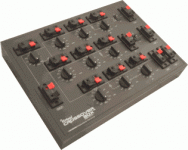Hi All,
Me again. I saw this thing on eBay; I also searched threads but couldn't find anybody who'd actually bought/used one. It doesn't explain very well how the thing works, but I think I have the general idea as to how to use it.
Does anybody have any hands-on experience with this? Would you recommend it for a crossover "dummy"? Although I want to go active/electronic at some point (i.e. Behringer etc.), right now something like this is well within my budget.
Thanks for any feedback.
Me again. I saw this thing on eBay; I also searched threads but couldn't find anybody who'd actually bought/used one. It doesn't explain very well how the thing works, but I think I have the general idea as to how to use it.
Does anybody have any hands-on experience with this? Would you recommend it for a crossover "dummy"? Although I want to go active/electronic at some point (i.e. Behringer etc.), right now something like this is well within my budget.
Thanks for any feedback.
Attachments
Hi,
seems not above 2nd order electrical, though depending on the
drivers and c/o points it can easily be 3rd to 4th order acoustic.
🙂/sreten.
seems not above 2nd order electrical, though depending on the
drivers and c/o points it can easily be 3rd to 4th order acoustic.
🙂/sreten.
Hi,
Acoustic is the shape of the crossover measured with a microphone,
whilst electrical is simply the voltage measured across the drivers.
e.g. a tweeter with Fs @ 1khz + 2Khz 2nd order electrical will have
an acoustic rolloff that is 4th order. The same applies to sealed back
midranges with Fs say 250Hz and c/o point say 400Hz.
The main problem with this sort of thing (adjustable c/o) is the
lack of EQ possibilities to compensate for driver deficiencies.
🙂/sreten.
Acoustic is the shape of the crossover measured with a microphone,
whilst electrical is simply the voltage measured across the drivers.
e.g. a tweeter with Fs @ 1khz + 2Khz 2nd order electrical will have
an acoustic rolloff that is 4th order. The same applies to sealed back
midranges with Fs say 250Hz and c/o point say 400Hz.
The main problem with this sort of thing (adjustable c/o) is the
lack of EQ possibilities to compensate for driver deficiencies.
🙂/sreten.
"Acoustic is the shape of the crossover measured with a microphone, whilst electrical is simply the voltage measured across the drivers."
I assume then, that acoustic is the final result one would be after? For example, if you are working with metal drivers and want to achieve 4th order to avoid cone break-up areas, etc. 2nd order electrical will work if 4th order acoustic is measured? Or not so simple?
"The main problem with this sort of thing (adjustable c/o) is the
lack of EQ possibilities to compensate for driver deficiencies."
By this do you mean equalizing drivers of different efficiencies? And/or other "deficiencies"?
I assume then, that acoustic is the final result one would be after? For example, if you are working with metal drivers and want to achieve 4th order to avoid cone break-up areas, etc. 2nd order electrical will work if 4th order acoustic is measured? Or not so simple?
"The main problem with this sort of thing (adjustable c/o) is the
lack of EQ possibilities to compensate for driver deficiencies."
By this do you mean equalizing drivers of different efficiencies? And/or other "deficiencies"?
sdclc126 said:"Acoustic is the shape of the crossover measured with a microphone, whilst electrical is simply the voltage measured across the drivers."
I assume then, that acoustic is the final result one would be after? For example, if you are working with metal drivers and want to achieve 4th order to avoid cone break-up areas, etc. 2nd order electrical will work if 4th order acoustic is measured? Or not so simple?
"The main problem with this sort of thing (adjustable c/o) is the
lack of EQ possibilities to compensate for driver deficiencies."
By this do you mean equalizing drivers of different efficiencies? And/or other "deficiencies"?
Hi,
Its not so simple. a metal driver with a huge peak may need
a 6th order electrical crossover to achieve 4th order acoustic.
Conversely if the acoustic target is 4th order linkwitz/riley and the driver
has a smooth roll-off possibly 2nd order electrical is all that is needed.
The adjustable crossover seems to have level adjusts to compensate
for different efficiencies, I meant "other deficiencies" e.g. peaks.
🙂/sreten.
sdclc126 said:Hi All,
Me again. I saw this thing on eBay; I also searched threads but couldn't find anybody who'd actually bought/used one. It doesn't explain very well how the thing works, but I think I have the general idea as to how to use it.
Does anybody have any hands-on experience with this? Would you recommend it for a crossover "dummy"? Although I want to go active/electronic at some point (i.e. Behringer etc.), right now something like this is well within my budget.
Thanks for any feedback.
Do yourself a favour and stay away from Behringer. Behringer delivers reasonably well for it's price, but if you want objective quality, you can get much better gear for a few bucks more. Look for Drawmer, BSS, BBX, Mackie, whatever (don't look for Phonic, though). I am a pro sound engineer/producer, both live and in studio's. Each time I have to use behringer anywhere in the setup, I just can't seem to get the sound and dynamics I want.
- Status
- Not open for further replies.
- Home
- Loudspeakers
- Multi-Way
- Vidsonix VCB-100 Crossover Design Box
